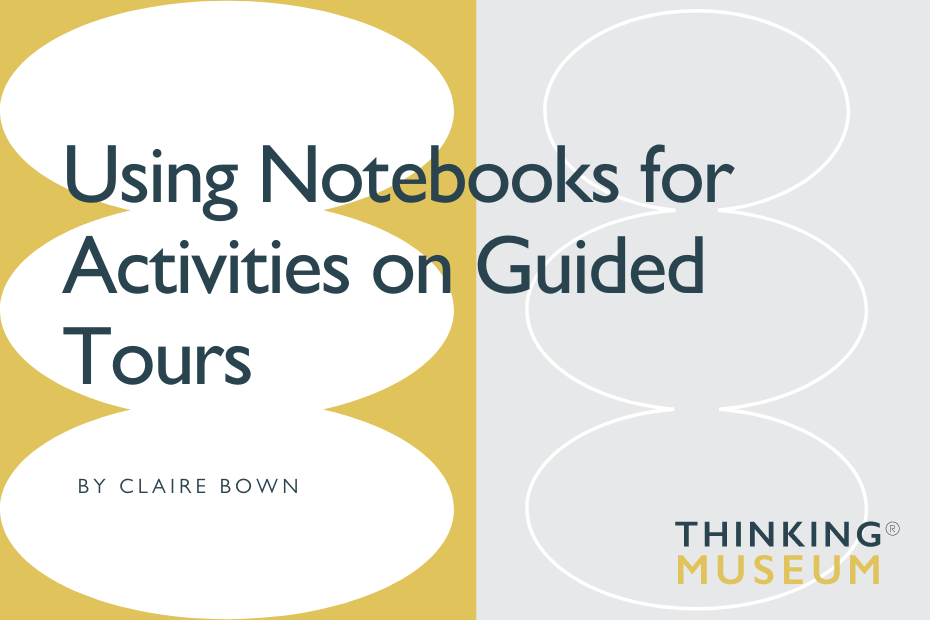In praise of the humble notebook…
I have hundreds of tips and tools in my head that I could share with you, but today I’ve decided to share my go-to and most simple tool – using notebooks for activities on guided tours.
A notebook, you say? But that’s not very exciting…
Well, when my three children were small, we used to go off to museums, galleries and places like the zoo armed with a small notebook and a pencil. I just told them that whenever they saw something they liked, they should make a note of it however they wanted – either with a drawing or by writing. It became a sort of journal for them that they could take out and add whatever they wanted, when they felt like it. It was the a simple but amazingly effective activity to keep them occupied and happy on days out!
But it’s not just useful for kids, I also take them on tours with adults too, so that we can do different activities together. It also avoids having to get out post-it notes or bulky clipboards.
Notebooks are great to use for planned activities and for the off-the-cuff spur-of-the-moment type of fun too!
What kind?
The type of notebook you choose is actually quite important – it needs to be small enough to be portable and have a hard enough cover so that you can write/draw in it without it bending. A strong card cover is the best. I typically go for A6 without lines, with a heavy card cover. It doesn’t have to be expensive either – all of the notebooks in the photo were under a Euro each.
You could also get notebooks that are themed to where you are taking your group and that they can take away with them as a souvenir. The Rijksmuseum used to do beautiful, colourful A6 notebooks that I used to handout as gifts on many of my family tours.
There are literally HUNDREDS of ways to use a notebook on a tour, but here are some of my faves:
Humble Notebook Inspiration
- Looking – Use for an observation-based activity such as Visible Thinking Routines like Looking Ten Times Two or the ‘see-ing’ part of See-Think-Wonder. Participants can write down (in pairs or individually) everything that they see. You can time them with a stopwatch to make it super-fast and fun!
- Drawing – in so many ways, here are just a few:
- Back-to-Back Drawing (the observer describes what they are looking at to the person with their back to the object, who then draws what is being described to them
- Blind Contour Drawing – drawing an object without taking your eyes off it!
- Sketching an object roughly and then labelling it’s parts
- Choosing your favourite object/artwork in a gallery and drawing it
- Make a drawing of what you see through a viewfinder and then making 3 changes to that drawing (you can provide crayons or coloured pencils here too)
- Poetry – using an adaptation of Visible Thinking Routine 3,2,1 Bridge to create 3 words, 2 phrases and 1 question about an object or building, then using those words to create a short poem!
- Travel Journal – make the notebook THEIR personal travel journal. Encourage them to add drawings, short sentences about anything they see that catches their attention. They can include anything – memories, weather, entrance tickets and interesting findings. It can be a personal endeavour or a joint activity for the whole group (say a family journal). Take photos too (an instamax camera is great for this as it’s instant) and add them in with some tape. Or use the journal to send a postcard home – choose someone to send the postcard to and describe the scene where you are right now – all the sights, sounds and excitement.
- Key Takeaways – Use the notebook to keep a record of your key takeaway from the tour or your response to the thinking routine ‘I used to think…now I think…‘
- Wonderings – Get the group to write down all the questions or wonderings that they have about a particular subject, theme of the tour or an object/artwork you’re looking at. You can do this individually or assign a notetaker! OR tell participants that if they have any questions throughout the tour, jot them down in their notebook and then they can remember them for later. You can assist by telling them the answer or you can attempt to find it out together.
- Create stories together – divide your group into smaller groups and ask each group to come up with a story in response to the artwork they are looking at. For example, ‘If this is the last scene in a film, what might happen next?’ Assign a notetaker to take notes on the discussion, so that they can re-tell the story to everyone or even ask the group to act it out!
There are many other ways you can use the humble notebook with groups on a guided tour. What else can you add to my list?
Sign up for my Curated newsletter
Every other Friday I share a small dose of curated inspiration. It might be things I’ve read, things I’ve listened to or things I’ve watched.
Hear about my latest podcast episode and read useful tips, recommendations and things that I love. Join via the button below.

Pingback: Quick Guide to Stress-Free Museum Visits with your Kids
Pingback: What is Slow Looking? (and How Can I Get Started?)
Comments are closed.